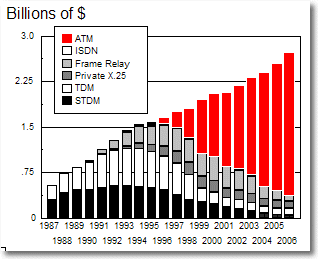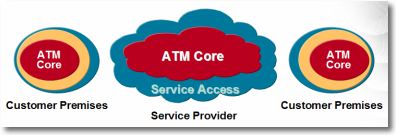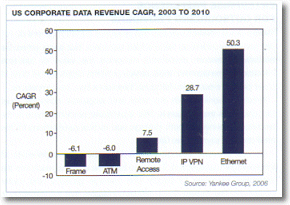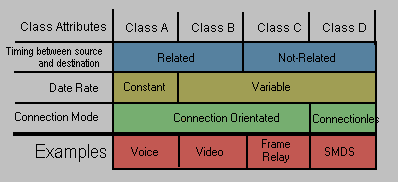Networks Part 1: The demise of ATM
January 2007
 It's said that a few weeks is long
time with the Internet, so it�s amazing to take a look at what has happened over 12 years in the network world that delivers the Internet to your door. You will detect a particular flavour to this
story and this is the subject of Quality of Service which has been a thread to many of my activities over the years.
It's said that a few weeks is long
time with the Internet, so it�s amazing to take a look at what has happened over 12 years in the network world that delivers the Internet to your door. You will detect a particular flavour to this
story and this is the subject of Quality of Service which has been a thread to many of my activities over the years.
We are all Lemmings in our own way following the latest trend and trying to be at the heart of whatever industry gestalt is seen to be the thing of the moment. So I thought I would kick this little mini-series off with a look back at the ATM �revolution� of the '90s for a global bandwagon that went belly up.
ATM stands for asynchronous transfer mode (ATM) which was standardised in 1988. ATM is a cell switching technology and along with synchronous digital hierarchy (SDH) transport, was meant to form the basis of the public broadband ISDN (B-ISDN). B-ISDN, also know as the Information Superhighway (what an archaic term) was the holy grail of the telecommunications industry before the Internet. I wrote a short overview of ATM way back in 1992.
Although ATM came out of the telecommunications world as it was standardised by the ITU in Geneva, it was soon picked up in that pre-IP world as a standard that could be used to converge the totally different worlds of WAN and LAN technologies to create seamless WAN/LAN infrastructures. At the time, the public data services world was just getting used to frame relay, a cut down X.25 service and private LANs were all about IP and Ethernet. The new gestalt had begun!

Converged Networks based on ATM
The diagram above was a typical slide of an equipment vendor of the time. ATM was the future for WANs! ATM was
the future for LANs ! By 97/98 every single one of the major WAN / LAN equipment vendors had huge ATM divisions and IP was just not on their strategic radar. Of course, there was
one exception to this and we all know who that was � Cisco.  A 1995
graph predicting European WAN Adapter Shipments from DataQuest (now Gartner) can be seen
above. This inaccurately predicted that ATM would steamroller all before it � this was the generally accepted view of the time. Domination would be achieved by 2006 funnily enough.
A 1995
graph predicting European WAN Adapter Shipments from DataQuest (now Gartner) can be seen
above. This inaccurately predicted that ATM would steamroller all before it � this was the generally accepted view of the time. Domination would be achieved by 2006 funnily enough.
The graph on the right from the Yankee Group shows 2006 reality which is slightly different. One big lesson in all this is to always look beyond what analysts say as they are invariably incorrect and just reflect currently held current views. No one can really predict the future! This holds true for today just as much it was in 1997.

It was clear to all that the core of both private and public networks would be ATM. Boy was this wrong. I guess the Company vision held by Fore in 1998 does with hindsight smack of a company burying its head in sand to avoid reality. Two of the biggest vendors, Fore and Newbridge stuck to their ATM guns until the very end with predictable consequences. Newbridge was sold to Alcatel and heaven knows why Marconi ( now Ericsson) bought Fore at a time when it was clear that ATM was dead.
ATM lived on for many years as an underlying transport for IP backbones and still survives today as the bearer in DSL. The latter is purely for legacy reasons as DSL dates back to the late 80s when ATM was being defined. So why did ATM die? The answer is quite easy really. In the LAN world IP and Ethernet were taking hold as the de facto standards and equipment based on those standards were so much simpler, easier to understand (better the devil you know) and significantly cheaper.
ATM equipment was expensive because it was primarily designed for the the service provider world. Also, it was easier to move Ethernet up to 100 Mbit/s, onto 1Gbit/s and 10Gbit/s today than jump ship to ATM. Software didn't need to changed and there were no 'driver' issues. Whereas, ATM would require a complete restart of hardware and software in the LAN environment and few IT departments were willing to bite that bullet for so few benefits. I wouldn't like to add up the overall cost to equipment vendors of developing ATM and then closing down all those divisions, but I bet it was a few $10bns!

ATM's classes of service
However, ATM has one real benefit that neither IP nor Ethernet had: defined classes of services. What this means that it was possible using ATM to give priority to real-time services (isochronous services) such as video or Voice over IP (VoIP) services over store-and-forward services such as e-mail or Internet access.
The lack of this capability in IP at that time had, in my opinion, a profound impact on just about everything that followed in the IP networking world. In fact you could say it was THE dominant issue that has influenced IP architecture ever since.
Looking back, I really did enjoy those days at all those conferences with my �ATM is dead� presentations - even if many disagreed at the time.
There was a particular seminal start-up that started the next phase of development of IP services. More on this in Part 2.
Next: Part 2: The flowering and dying of Ipsilon.
